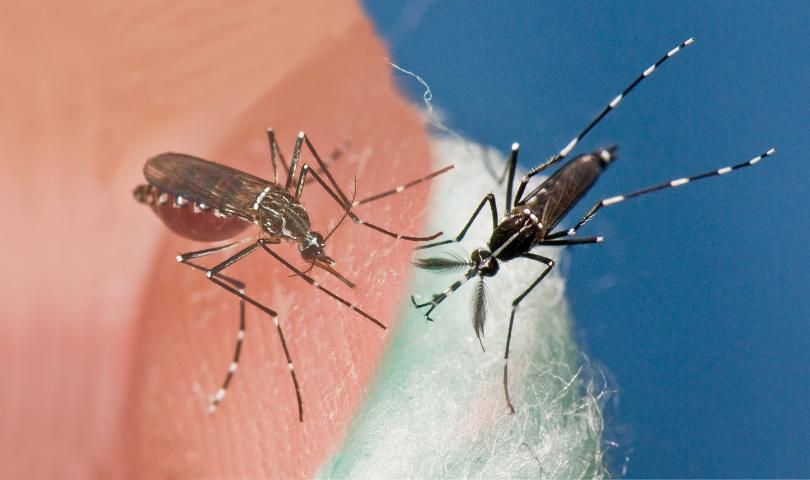
by Mary Salinas | Jul 7, 2016
The Zika virus has made us all more aware of the need to avoid getting bit by mosquitoes when we travel to those destinations that have confirmed reports of Zika infected mosquitoes. The Centers for Disease Control and Prevention lists the countries and territories that have travel notices to consult prior to planning a trip or traveling.
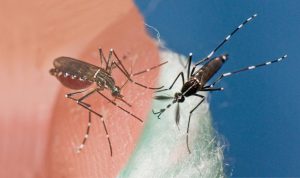
The invasive mosquitoes Aedes aegypti (left) and Aedes albopictus (right) occur in the Americas, including Florida, and have been implicated in the transmission of Zika virus.
Credit: J Newman, UF/IFAS/FMEL
The Florida Department of Health has recommendations for preventative action to take when traveling to any location that has confirmed Zika virus.
- You should use an insect repellant (following all label instructions) with any of these active ingredients:
- DEET
- Picaridin
- Oil of lemon eucalyptus
- Para-menthane diol
- IR3535
- Wear long-sleeved shirts and pants
- Wear clothing that is pre-treated with permethrin or apply a permethrin product to your clothes, but not your skin!
- Avoid getting bitten while you sleep by choosing a place with air conditioning or screens on windows and doors or sleep under a mosquito bed net.
According to the Georgia Department of Public Health you should also protect yourself against mosquito bites for at least a week after you return home from any location that has confirmed Zika. You may have an active infection without symptoms that can be spread to others through mosquito bites.
Now let’s talk about mosquito control in your own landscape.
Even though we don’t have confirmed Zika infection in Florida mosquitoes at this writing, mosquitoes in our state can transmit other diseases such as: eastern equine encephalitis, dengue fever, dog or cat heartworm, chikungunya, malaria, St. Louis encephalitis and west Nile virus.
Let’s first explore what kind of environment in your landscape and around your home is friendly to the proliferation of mosquitoes. Adult mosquitoes lay their eggs on or very near water that is still or stagnant. That is because the larvae live in the water but have to come to the surface regularly to breeze. The small delicate larvae need the water surface to be still in order to surface and breathe. Water that is continually moving or flowing inhibits mosquito populations.
Look around your home and landscape for these possible sites of still water that can be excellent mosquito breeding grounds:
- bird baths
- potted plant saucers
- pet dishes
- old tires
- ponds
- roof gutters
- tarps over boats or recreational vehicles
- rain barrels (screen mesh over the opening will prevent females from laying their eggs)
- bromeliads (they hold water in their central cup or leaf axils)
- any other structure that will hold even a small amount of water (I even had them on a heating mat in a greenhouse that had very shallow puddles of water!)
You may want to rid yourself of some of these sources of standing water or empty them every three to four days. What if you have bromeliads, a pond or some other standing water and you want to keep them and yet control mosquitoes? There is an environmentally responsible solution. Some bacteria, Bacillus thuringiensis ssp. israelensis or Bacillus sphaericus, only infects mosquitoes and other close relatives like gnats and blackflies and is harmless to all other organisms. Look for products on the market that contain this bacteria.
For more information:
Zika, a Mosquito-Transmitted Virus
Mosquito Repellents
UF/IFAS Mosquito Information Website
Florida Container Mosquitoes
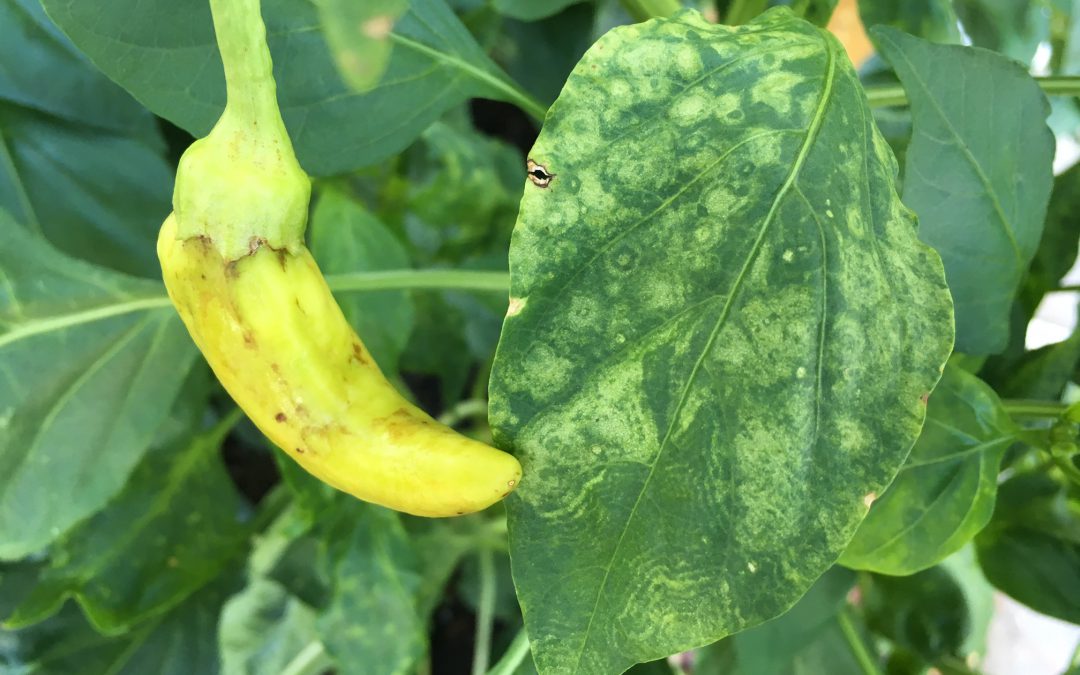
by Mary Salinas | Jul 7, 2016
Peppers and tomatoes are in the same plant family – solanaceae or more commonly known as the nightshade family – and can be susceptible to some of the same diseases. This is true of Tomato Spotted Wilt Virus (TSWV). The solanaceae family includes potatoes, eggplant, tobacco, petunia, tomatillo and deadly nightshade in addition to pepper and tomato.

Pepper with TSWV. Photo credit: Mary Derrick, UF IFAS Extension.
This virus is spread by very small insects known as thrips. They acquire the virus as larvae when feeding on an infected plant and then transmit the disease when they fly to other susceptible plants as adults.
Initial symptoms are yellowing and distortion of the leaves. The leaves can also display yellow or brown circular ring spots. The severity of the virus can depend on the particular cultivar of pepper, its age and the environmental conditions in which the pepper is growing. Fruit can develop yellow, brown or ring spots as well.
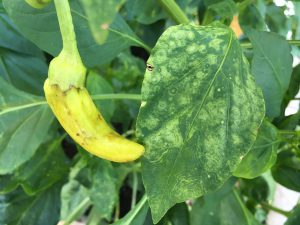
TSWV infection showing ring spot on leaves and lesions on fruit. Photo credit: Mary Derrick, UF IFAS Extension.
If you think your pepper has TSWV, consult your local extension agent to confirm the diagnosis. But once infected, there is no treatment for the plants and they should be pulled up and disposed of in the trash to prevent other susceptible plants from becoming infected.
For more information:
Some Common Diseases of Pepper in Florida
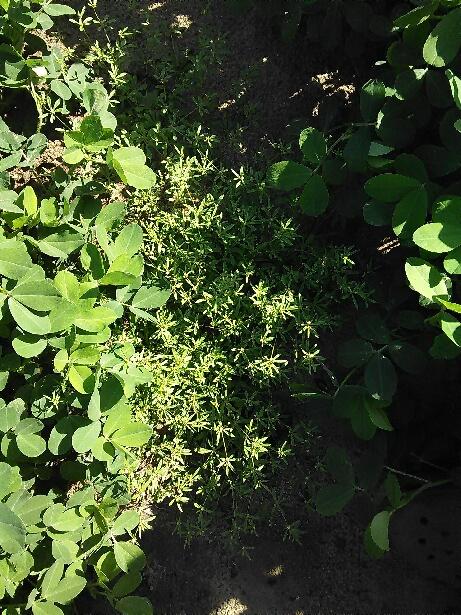
by Mark Tancig | Jul 5, 2016

When you don’t know what’s ailing your plant, ask an expert.
Many gardeners get stumped when a favorite plant of theirs comes down with a strange “something”. Many of these gardeners know about UF/IFAS Extension and call their local horticulture and agriculture agents for assistance in figuring out what’s going on. However, even these experts are often stumped by what they see. Fortunately, the agents have another layer of experts to fall back on. In addition to the resources in Gainesville, we have the Plant Disease Diagnostic Clinic, located at the North Florida Research Center in Quincy. Plant pathologists here can help determine what fungus, bacteria, virus, or viroid may be the problem.
Plant pathologists are basically plant doctors. They use all sorts of sophisticated techniques to determine what is the cause of a particular plant problem, from growing out fungal spores to examining DNA. Not only do these plant doctors tell us what the ailment is, they also provide recommended cures, or control options. They are also doing research to prevent different diseases from taking hold in our area and reduce the impact on our local growers.

Plant pathologist at work!
At a recent workshop in Quincy, we learned that plant pathology researchers are working on a fungus that affects watermelons, virus and bacteria that can wipe out a farmer’s tomato crop, and a virus that could impact our local roses. Working as a team of scientists, they study these pathogens in the lab and conduct controlled field experiments to figure out which techniques are most effective. Some of this research is leading to different methods and/or products that can help growers and gardeners alike keep their fields and landscapes healthy.
So, if your plants have problems, please contact your local Extension Office. If they don’t know the answer, then the network of scientists, including plant pathologists, in the UF/IFAS Extension family can be called on for backup to provide you with the best possible answer.
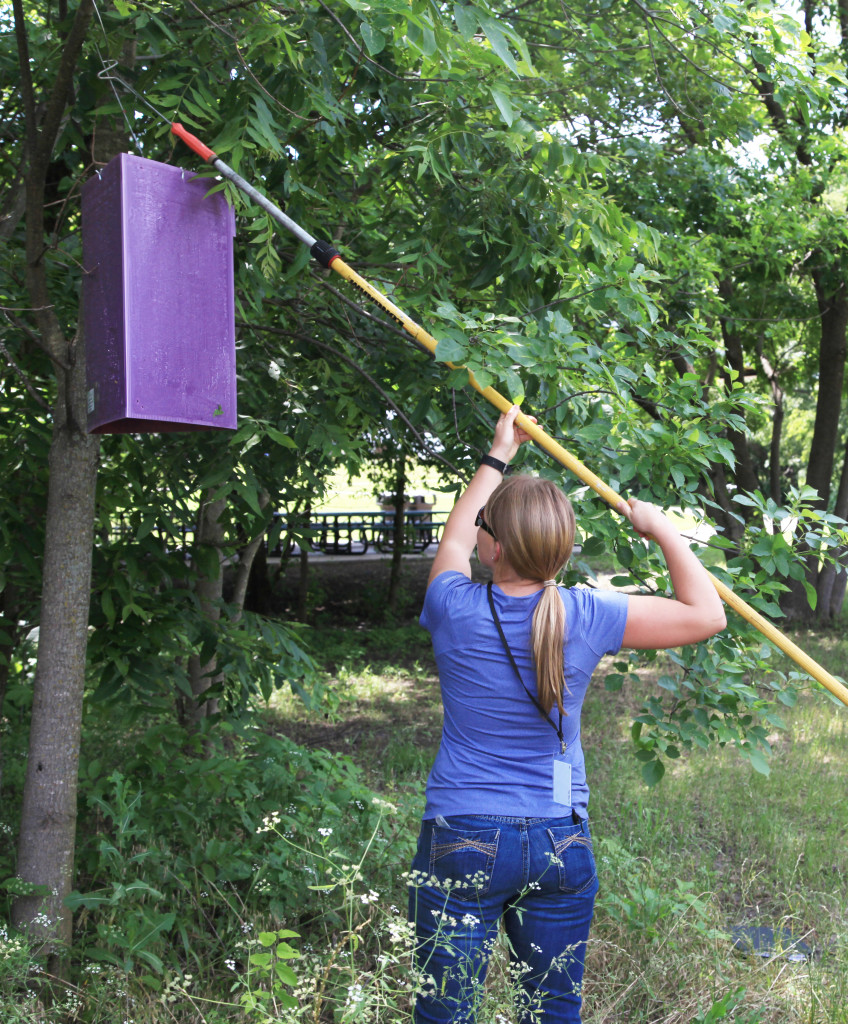
by Matt Lollar | May 24, 2016
From time to time I am reminded of how little I know. Honestly, I am reminded on a daily basis. A few weeks ago someone asked me about the purple things hanging from the trees. Luckily, the person gave me some good southern directions on where I could find one of these things hanging around in Marianna. So I drove out to the site to get a better look. What I saw hanging in the tree was a three-sided, purple triangle about two feet tall and a foot wide. It looked to me like someone got a box kite stuck in a tree. Upon further research, it was determined this box kite like thing was a monitoring trap for the emerald ash borer (EAB).
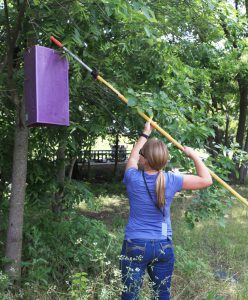
A woman hanging an emerald ash borer trap in a tree. Photo Credit: Texas A&M University
The emerald ash borer (EAB) is a destructive, exotic wood-boring beetle native to Asia. It was first discovered in North America in July 2002 and has made a home in Michigan, Ohio and Ontario, Canada. Millions of ash trees have been killed by the EAB in Michigan and invested ash tree nursery stock in other states indicates the potential for increased spread of the pest. EAB has made its way to the south and has been found in Louisiana and Arkansas.
Monitoring traps are not the only means of EAB detection. A proactive approach utilizing observant citizens can help keep an eye out for potential populations. You can use these tips to monitor your community for emerald ash borers:
Ash Tree Identification – Ash trees are identified by their (1) opposite branching pattern, (2) compound leaves with 5-9 leaflets, and (3) diamond shaped bark ridges on mature trees.
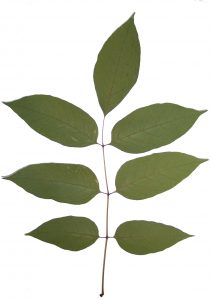
A compound leaf of an ash tree. Photo Credit: FDACS
Woodpecker Damage – Of course, not all woodpecker damage on ash trees is associated with EAB infestation, but woodpecker damage in the upper part of the tree can indicate their presence. The woodpecker damage is usually accompanied by vertical cracks in the bark.
Canopy Thinning – As the attack progresses, bark cracking continues and the canopy in the upper half of the tree begins to thin.
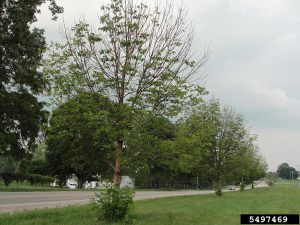
Michigan ash tree showing decline due to Emerald ash borer. Photo Credit: USDA
Tunnels and Holes – The emerald ash borer makes distinctive S-shaped tunnels that differ from damage from other borers.
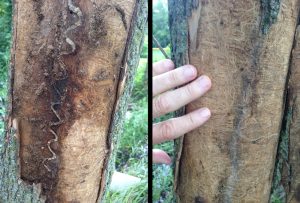
EAB Damage (left) VS Other Borer Damage (right). Photo Credit: Texas A&M University
This beetle hitchhikes on firewood and infests new areas at an alarming rate. Although the EAB has not yet been detected in Florida, transporting firewood from other states puts Florida ash trees at risk. Your help is needed to detect possible infestations so they can be quickly eradicated. The information available at the following links will help you identify the EAB, EAB host trees, and infestation symptoms.
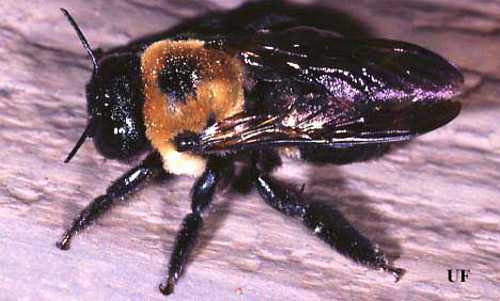
by Les Harrison | May 17, 2016
The hectic pace to contemporary life can justifiably be compared to the seemingly erratic behavior of insect pollinators. Darting from flower to flower with no apparently logical progression for choice of blooms, all the while emitting a mind numbing buzz.
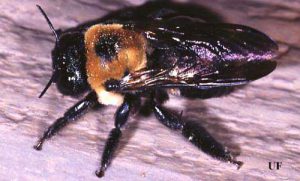
Adult large carpenter bee, Xylocopa sp. Photograph by Paul M. Choate, University of Florida.
This incessant and unending grind of bouncing from task to task has created an atmosphere of tedium and monotony which has become the anthem of many adults. As quick as one chore is complete, another replaces it. Russian composer Nokoli Rimsky-Korsakov wrote what might be considered today’s theme song at the dawn of the 20th century. “Flight of the Bumblebee” catches the frantic haste at which this insect functions, as well as its commonly encountered cousin the carpenter bee.
Bumblebees and carpenter bees are very similar in behavior, coloration and size. The easiest way to differentiate these insects is by their abdomen, the body segment furthest from the head. Bumblebees have an abdomen thickly covered in fine hairs. Carpenter bees lack the fine hairs and have a shiny abdomen.
Xyloxop micans Lepeletier, as the large carpenter bee is known scientifically, is one of more than 500 species worldwide. Almost all members of this genus build their nest by burrowing into dead wood. In the wilds of the panhandle this usually means deadfall timber of almost any sort. Unfortunately, in the areas which include human structures, the nesting sites include wooden timbers and siding.
Unlike European honeybees, the carpenter bees are labeled as solitary bees. There may, however, be several nests in close proximity to these active insects.
Nests are composed of a single parent that lays eggs in a segmented tubular nest. The nest openings are a nearly perfect 5/8 inch (16 mm) hole. Each nest has only a single opening, but multiple tunnels will branch off the main passage. These bees do not eat the wood removed to create the nest channels. Sometimes the holes are not visible to the observer, but the wood emits a buzzing or humming sound when these bees are nesting in hidden locations. In many cases small quantities of saw dust can be found on the ground under the hidden nest.
Heavy or repeated infestations can weaken structural timbers and severely damage siding. Decay and breakage will ultimately follow an untreated incursion.
While the damage caused by carpenter bees can be quite expensive, they may attract an even more destructive predator. Woodpeckers, especially the native pileated woodpecker, dine on carpenter bee larvae at every opportunity. These feathery insect assassins are attracted to the vibrations and hums of the bees hidden in wood. In some cases, the wood acts as a resonator and amplified the insect noise which assures an aerial assault. When discovery of the larvae is confirmed, the woodpeckers attack with a ferocity seldom seen in nature. The rapid-fire staccato of their hammering is loud and devastating.
Structural supports are compromised far beyond the damage done by the carpenter bees, and at a quicker rate. Siding is often shredded and left completely useless.
Commonly available insecticides can help control the carpenter bee population and reduce the prospects of woodpecker damage. Unfortunately, this only adds one more item to the long list of chores and task of contemporary adults.
For more information:
Featured Creatures: Large Carpenter Bees
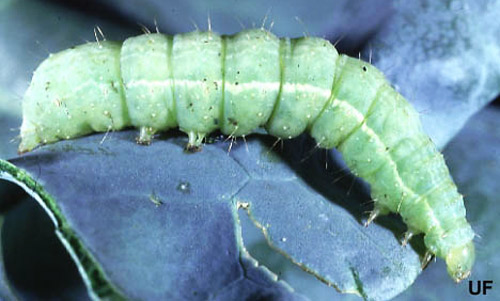
by Blake Thaxton | May 17, 2016
In the last few weeks, more garden pests have arrived! It is a fact of life in northwest Florida that we will have a few things in our garden including heat, moisture (humidity and rainfall), and BUGS! With a cooler spring the arrival of some of the troublesome pests in the garden seemed to be delayed a few weeks. It was nice while it lasted but the insect pests are here to stay until frost in the fall or winter (at least we hope for a frost this year).
There are thousands of insects that you can see in your garden. It’s wise to identify them before making a decision to spray an insecticide or remove them by another method. Insect samples can be taken to your local county extension office for identification.
In this article we will just discuss one of the top insect pests in the vegetable garden, caterpillars, and what you can do about them.

Mature larva of the cabbage looper. Photograph by John L. Capinera, University of Florida.
Beet armyworms, fall armyworms, hornworms, cabbage loopers, southern armyworms, tomato fruitworms, and other caterpillars love to feed on tomato foliage and fruit. They will show up eventually on tomato plants in the garden, if not this year then in the future. These larvae are immature moths and cause a lot of damage if left unchecked. The homeowner can control them effectively with Organic Materials Review Institute (OMRI) approved pesticides. A bacterial biological insecticide called Bacillus thuringiensis, also referred to as B.t., can be very effective in controlling these caterpillar pests. B.t. is a stomach toxin to these pests and will cause them to quit eating and starve to death. The key to using B.t. effectively is to routinely apply it before the caterpillars hatch from their eggs as the smaller caterpillars are easiest to control. Larger caterpillars are more difficult to control.
For more information related to using OMRI pesticides:
Organic Vegetable Gardening in Florida
Insecticides for Organic Commercial & Backyard Vegetable Production

















